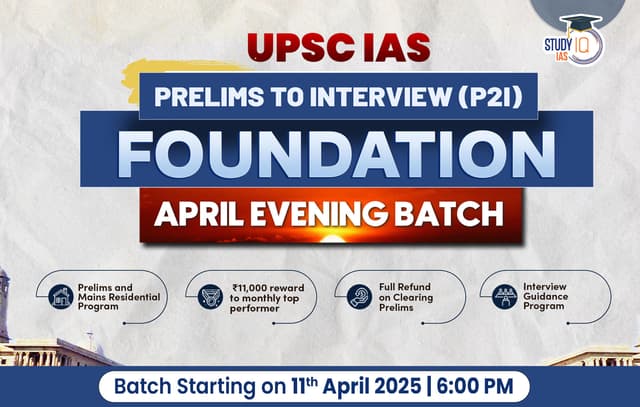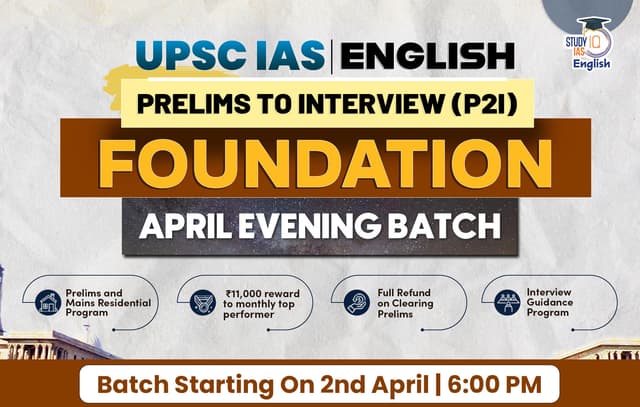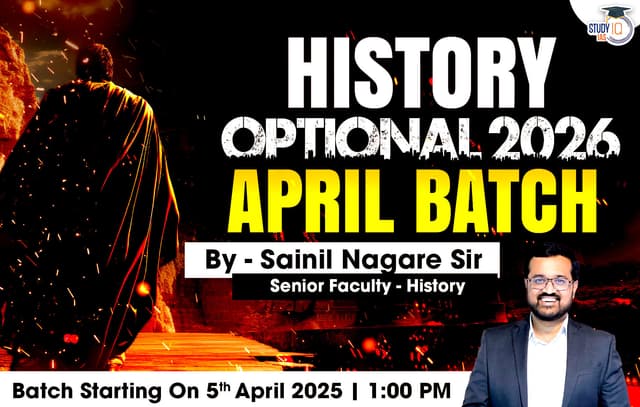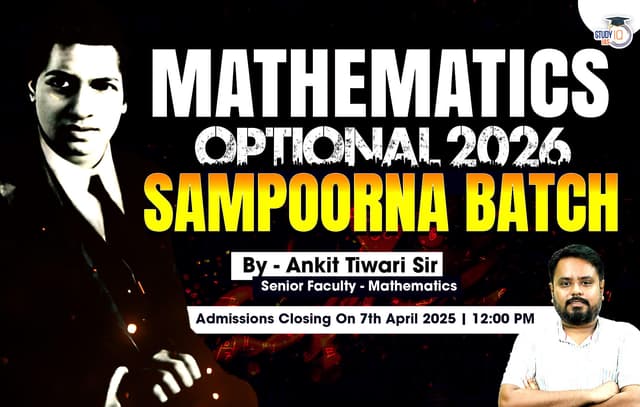Daily Quiz 18 January 2025
Quiz-summary
0 of 5 questions completed
Questions:
- 1
- 2
- 3
- 4
- 5
Information
- Click on – ‘Start Quiz’ button
- Solve Questions
- Click on ‘Next’ button
- Click on ‘Finish Quiz’ button
- Now click on ‘View Questions’ button – here you will see solutions and links.
- The test contains a total of 5 questions.
- Click on the most appropriate option to mark it as your answer.
- You will be awarded Two marks for each correct answer.
- You can change your answer by clicking on some other option.
- A Number list of all questions appears at the top side of the screen.
- You can access the questions in any order by clicking on the question number given on the number list.
- You can use rough sheets while taking the test.
- Do not use calculators, log tables, dictionaries, or any other printed/online reference material during the test.
- Do not click the button “Finish Quiz” before completing the test. A test once submitted cannot be resumed.
You have already completed the quiz before. Hence you can not start it again.
Quiz is loading...
You must sign in or sign up to start the quiz.
You have to finish following quiz, to start this quiz:
- 1
- 2
- 3
- 4
- 5
- Answered
- Review
-
Question 1 of 5
1. Question
1 pointsConsider the following statements with reference to Soapstone:
1. It is a metamorphic rock made of talc.
2. It is highly resistant to etching and chemical reactions.
3. Rajasthan and Uttarakhand have substantial reserves of soapstone in India.
How many of the above statements are correct?Correct
Answer: C
Explanation:
● Statement 1 is correct: Soapstone, also known as steatite, is a metamorphic rock composed primarily of talc, with varying amounts of chlorite, micas, amphiboles, and other minerals like carbonates, magnesium, silicate, etc. Most soapstone deposits were formed from 300 to 400 million years ago, and they can be found throughout the world. The name soapstone is derived from its “soapy” feel that is soft to the touch caused by the talc in the stone which exudes a sensation similar to that of a dry bar of soap.
● Statement 2 is correct: Soapstone is primarily talc, which is chemically inert, that is why it is highly resistant to etching and chemical reactions.
● Statement 3 is correct: According to the Indian Bureau of Mines, the states of Rajasthan (57%) and Uttarakhand (25%) boast substantial reserves of soapstone in India.Incorrect
Answer: C
Explanation:
● Statement 1 is correct: Soapstone, also known as steatite, is a metamorphic rock composed primarily of talc, with varying amounts of chlorite, micas, amphiboles, and other minerals like carbonates, magnesium, silicate, etc. Most soapstone deposits were formed from 300 to 400 million years ago, and they can be found throughout the world. The name soapstone is derived from its “soapy” feel that is soft to the touch caused by the talc in the stone which exudes a sensation similar to that of a dry bar of soap.
● Statement 2 is correct: Soapstone is primarily talc, which is chemically inert, that is why it is highly resistant to etching and chemical reactions.
● Statement 3 is correct: According to the Indian Bureau of Mines, the states of Rajasthan (57%) and Uttarakhand (25%) boast substantial reserves of soapstone in India. -
Question 2 of 5
2. Question
1 pointsConsider the following:
- Former Prime Minister
- Minister of Union
- Member of Lok Sabha
- Former Chief Justice of India
How many of the above can a complaint be filed against with the Lokpal of India under the Lokpal and Lokayuktas Act, 2013?
Correct
Answer: C
Explanation:
- Lokpal and Lokayuktas Act, 2013 predates establishment of a high powered body called the Lokpal of India.
- Lokpal, as a body, is bestowed with wide powers to direct inquiry investigation and to accord sanction to prosecute the public officials/functionaries referred to in Section 14 of the Lokpal and Lokayuktas Act, 2013 and other persons involved in commission of offence of corruption.
- Points 1, 2 and 3 are correct: In terms of Section 14 of the Act, a complaint can be filed against any person who is or has been a Prime Minister, any person who is or has been a Minister of Union, any person who is or has been a Member of either House of Parliament.
Point 4 is not correct: According to the Supreme Court of India, sitting judge of the Supreme Court or the Chief Justice of the Supreme Court will not be amenable to the constricted jurisdiction of the Lokpal of India in terms of Section 14 of the Act of 2013. Thus a complaint cannot be filed with the Lokpal of India under the Lokpal and Lokayuktas Act, 2013 against the Chief Justice of India.
Incorrect
Answer: C
Explanation:
- Lokpal and Lokayuktas Act, 2013 predates establishment of a high powered body called the Lokpal of India.
- Lokpal, as a body, is bestowed with wide powers to direct inquiry investigation and to accord sanction to prosecute the public officials/functionaries referred to in Section 14 of the Lokpal and Lokayuktas Act, 2013 and other persons involved in commission of offence of corruption.
- Points 1, 2 and 3 are correct: In terms of Section 14 of the Act, a complaint can be filed against any person who is or has been a Prime Minister, any person who is or has been a Minister of Union, any person who is or has been a Member of either House of Parliament.
Point 4 is not correct: According to the Supreme Court of India, sitting judge of the Supreme Court or the Chief Justice of the Supreme Court will not be amenable to the constricted jurisdiction of the Lokpal of India in terms of Section 14 of the Act of 2013. Thus a complaint cannot be filed with the Lokpal of India under the Lokpal and Lokayuktas Act, 2013 against the Chief Justice of India.
-
Question 3 of 5
3. Question
1 pointsWhich one of the following is a key feature of artesian wells that differentiates them from other wells?
Correct
Answer: C
Explanation:
- Option C is correct: Artesian aquifer refers to water stored under pressure, between layers of sediments and soil below the earth’s surface. It is also described as “confined” water because of hardy materials above and below it. The word “artesian” is specifically used when water is “confined under pressure below layers of relatively impermeable rock.”
- What differentiates it from water flowing normally through tube wells or wells is that artesian water can sprout from underground on its own and is also located deeper below the earth’s surface. It is surrounded by poorly permeable rocks that result in high pressure underground. When a rupture (like through drilling) happens, that underground pressure forces water upward and toward land.
- Option A is not correct: Artesian wells do not rely solely on manual pumping; the natural pressure can cause water to flow without external aid.
- Option B is not correct: Artesian wells are surrounded by poorly permeable (impermeable) rock layers, not highly permeable ones
- Option D is not correct: Artesian wells are not necessarily located in regions where the water table is at ground level; they are usually deeper.
Incorrect
Answer: C
Explanation:
- Option C is correct: Artesian aquifer refers to water stored under pressure, between layers of sediments and soil below the earth’s surface. It is also described as “confined” water because of hardy materials above and below it. The word “artesian” is specifically used when water is “confined under pressure below layers of relatively impermeable rock.”
- What differentiates it from water flowing normally through tube wells or wells is that artesian water can sprout from underground on its own and is also located deeper below the earth’s surface. It is surrounded by poorly permeable rocks that result in high pressure underground. When a rupture (like through drilling) happens, that underground pressure forces water upward and toward land.
- Option A is not correct: Artesian wells do not rely solely on manual pumping; the natural pressure can cause water to flow without external aid.
- Option B is not correct: Artesian wells are surrounded by poorly permeable (impermeable) rock layers, not highly permeable ones
- Option D is not correct: Artesian wells are not necessarily located in regions where the water table is at ground level; they are usually deeper.
-
Question 4 of 5
4. Question
1 pointsWith reference to the collegium system for the appointment of Judges in India, consider the following statements:
- The Collegium system finds its mention under Article 124 of the Constitution of India.
- The Chief Justice and four of the most senior judges make up the Supreme Court Collegium for the appointment to the Supreme Court.
Which of the statements given above is/are correct?
Correct
Answer: B
Explanation:
- In India, until 1993, the appointment of judges was done by the President in consultation with the Chief Justice and two other senior-most judges of the Supreme Court. Since 1993, it is the Collegium system evolved by the Supreme Court that decides on appointments and transfers of judges in the higher judiciary, though the nominal appointing authority is the President of India.
- Statement 1 is not correct: The Collegium system finds no mention in the Constitution of India. It has evolved through the Supreme Court’s own three judgments, known collectively as the Three Judges Cases (1981, 1993 and 1998).
- Statement 2 is correct: Under the Collegium system, the Chief Justice of India and his 4 senior-most colleagues make recommendations for the candidates to be appointed as Supreme Court and High Court judges to the President.
- For appointments to the high courts, the Supreme Court Collegium consists of only 3 judges – The Chief Justice of India and two senior-most judges.
For appointments to the Supreme Court, the Collegium consists of five judges.
Incorrect
Answer: B
Explanation:
- In India, until 1993, the appointment of judges was done by the President in consultation with the Chief Justice and two other senior-most judges of the Supreme Court. Since 1993, it is the Collegium system evolved by the Supreme Court that decides on appointments and transfers of judges in the higher judiciary, though the nominal appointing authority is the President of India.
- Statement 1 is not correct: The Collegium system finds no mention in the Constitution of India. It has evolved through the Supreme Court’s own three judgments, known collectively as the Three Judges Cases (1981, 1993 and 1998).
- Statement 2 is correct: Under the Collegium system, the Chief Justice of India and his 4 senior-most colleagues make recommendations for the candidates to be appointed as Supreme Court and High Court judges to the President.
- For appointments to the high courts, the Supreme Court Collegium consists of only 3 judges – The Chief Justice of India and two senior-most judges.
For appointments to the Supreme Court, the Collegium consists of five judges.
-
Question 5 of 5
5. Question
1 pointsWhich one of the following has been entrusted with the work of interlinking of rivers under the National Perspective Plan (NPP)?
Correct
Answer: C
Explanation:
- Option C is correct: The National Water Development Agency (NWDA), was set up in July 1982 as Autonomous Society under the societies registration act 1860, to carry out the water balance and other studies on a scientific and realistic basis for optimum utilization of water resources of the Peninsular river system for preparation of feasibility reports and thus to give concrete shape to Peninsular river development component of National perspective plan prepared by Central Water Commission and the Ministry of Jal Shakti, Department of Water Resources, River Development & Ganga Rejuvenation.
- In the year 1990, NWDA was also entrusted with the task of Himalayan Component of the National Perspective Plan.
In 2006, it was decided that NWDA will explore the feasibility of intra-states links and to take up the work for preparation of Detailed Project Report (DPR) of river link proposals under National Perspective Plan (NPP).
Incorrect
Answer: C
Explanation:
- Option C is correct: The National Water Development Agency (NWDA), was set up in July 1982 as Autonomous Society under the societies registration act 1860, to carry out the water balance and other studies on a scientific and realistic basis for optimum utilization of water resources of the Peninsular river system for preparation of feasibility reports and thus to give concrete shape to Peninsular river development component of National perspective plan prepared by Central Water Commission and the Ministry of Jal Shakti, Department of Water Resources, River Development & Ganga Rejuvenation.
- In the year 1990, NWDA was also entrusted with the task of Himalayan Component of the National Perspective Plan.
In 2006, it was decided that NWDA will explore the feasibility of intra-states links and to take up the work for preparation of Detailed Project Report (DPR) of river link proposals under National Perspective Plan (NPP).
Results
0 of 5 questions answered correctly
Your time:
Time has elapsed
You have reached 0 of 0 points, (0)
| Average score |
|
| Your score |
|
Categories
- Not categorized 0%
| Pos. | Name | Entered on | Points | Result |
|---|---|---|---|---|
| Table is loading | ||||
| No data available | ||||
Sharing is caring!

 Gender Gap in Household Chores Persists ...
Gender Gap in Household Chores Persists ...
 India’s Nuclear Energy Strategy, Futur...
India’s Nuclear Energy Strategy, Futur...
 Daily Quiz 01 April 2025
Daily Quiz 01 April 2025





















